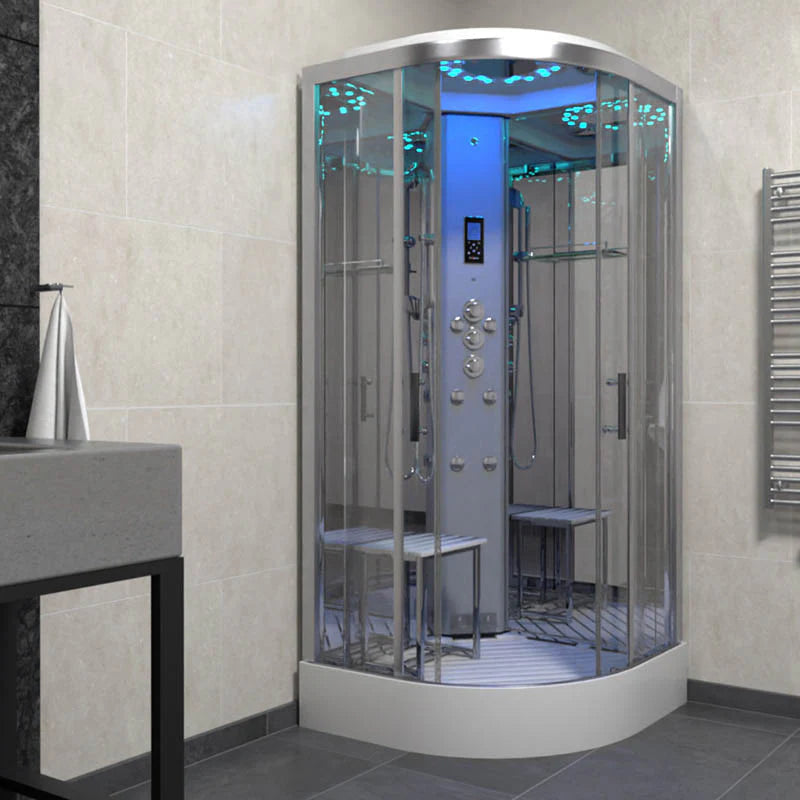Ever felt like your steamy shower turned into a steam room or steam bath sauna session? Wondering can shower steam suffocate you?n Short answer: No—but it can make breathing tricky if you’re not careful.
Keep reading to uncover the sneaky risks and smart safety tips you didn’t know you needed.

Understanding the Myth vs. Reality
The "Drowning from Steam" Misconception
No, shower steam won’t drown you. It’s physiologically impossible for steam to condense in your lungs and cause suffocation.
The lungs are designed to deal with moisture. They use natural reflexes like coughing and mucus production to keep the airways clear.
Moisture doesn’t pool or collect—it’s expelled naturally as part of normal respiration.
Origin of the Myth
This myth likely started with confusion around how steam affects the body. People who feel dizzy or breathless in the shower might mistake that for a sign of “drowning”.
Add in a few urban legends or dramatic posts online, and it’s easy to see how the idea spread.
But these symptoms are usually linked to heat or poor ventilation—not actual suffocation.
How Your Body Handles Steam and Humidity
Natural Respiratory Defences
Your respiratory system is well-equipped to handle humid air. When steam is inhaled, your body responds by filtering and regulating the moisture.
Cilia (tiny hair-like structures) and mucus help trap particles and keep your airways clear.
If anything feels “too much”, your body makes you cough or adjust your breathing rate.
Benefits of Steam for Respiration
Steam isn’t all bad—it can be helpful. It’s often used to relieve symptoms from colds, congestion, or even croup.
The warm moisture helps loosen mucus, soothe the airways, and improve airflow.
That’s why steam baths and inhalation therapies are still commonly used at home or in clinics.
Real Risks and Concerns in a Steamy Shower (Beyond Suffocation)
Heat-Related Issues
Dizziness and Fainting
Long, hot showers can lower your blood pressure. Heat causes your blood vessels to widen, which may reduce blood flow to the brain.
The result? You might feel dizzy, weak, or like you’re about to faint—especially if you're standing still in a very hot, enclosed space.
Heat Exhaustion/Stroke
Prolonged exposure to high temperatures can lead to heat exhaustion or, in extreme cases, heatstroke.
While rare during normal showers, these are real risks in steam rooms or baths without breaks.
Oxygen Displacement in Poorly Ventilated Spaces
The Role of Ventilation
Water vapour in a small, sealed bathroom can reduce oxygen levels. It doesn’t remove oxygen, but it displaces it—making fresh air harder to breathe.
The result is often light-headedness, faster breathing, or mild panic.
Using a fan or leaving a door slightly open solves this quickly.
Vulnerable Individuals
People with asthma, COPD, or similar conditions may notice symptoms sooner.
Steam can temporarily increase inflammation or make it harder to breathe if the air is stale.
This group should always use proper ventilation and keep sessions short.
Mould and Air Quality
High Humidity and Mould Growth
Bathrooms love mould. When humidity stays high for too long, mould grows on walls, ceilings, tiles, and corners.
Breathing in mould spores can trigger coughing, allergies, and asthma symptoms.
You may not even see it right away—but your lungs might notice first.
Water Contaminants
Shower steam may carry microscopic particles from the water itself.
These could include chlorine, metals, or bacteria—depending on your water quality.
While rare, prolonged exposure to these in vapour form could irritate sensitive lungs.
Safe Showering Practices and Prevention

Ensure Adequate Ventilation
Use Exhaust Fans
Always run your bathroom fan during and after your shower.
It helps remove excess steam and keeps humidity at a safer level.
This not only improves air quality but also helps prevent mould.
Open Windows/Doors
No fan? No problem. Just crack open a window or leave the bathroom door slightly ajar.
Fresh airflow helps keep oxygen levels stable and stops the room from overheating.
Manage Shower Temperature and Duration
Moderate Heat
Skip the scalding water. Go for warm or mildly hot instead.
It’s gentler on your body, safer for your lungs, and better for your skin too.
Shorter Showers
Limit your time to 10–15 minutes.
This helps control steam build-up, keeps your bathroom drier, and makes you feel better afterward.
Maintain Bathroom Hygiene
Prevent Mould Growth
Wipe down surfaces, use a squeegee, and clean your tiles regularly.
A dry bathroom is a healthier one.
Controlling humidity also means less chance of respiratory irritation from mould spores or bacteria.
Takeaways
-
Can shower steam suffocate you? No—but too much heat and poor ventilation can cause breathing issues.
-
Steam baths and steam rooms are generally safe in moderation, but they still carry some health risks.
-
People with respiratory conditions should be extra cautious in steamy environments.
-
Ventilation, time limits, and hygiene are your best tools for safe steaming.
-
Mould, heat exhaustion, and oxygen displacement are real concerns if you ignore steam safety.
Conclusion
Steam can feel soothing, especially in a hot shower or relaxing steam bath. While the idea of suffocating from steam might sound dramatic, it’s mostly a myth.
That said, steamy showers aren’t risk-free—especially if your bathroom lacks proper airflow or you overstay your welcome.
By staying aware, keeping your showers short, and maintaining good ventilation and hygiene, you can enjoy all the benefits of steam without any of the trouble.
Breathe easy—you’re in control.






